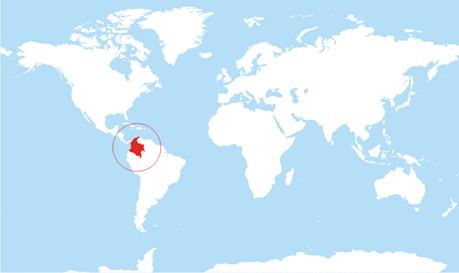| Overview (World Fact Book) |
| |
| Area Population GDP Key economic sectors | 1,138,910 sq km 46,736,728 (July 2015 est.) $665 billion (PPP 2015 est.), $274.2 billion (Off. Exch. Rate 2015 est.) Agriculture: 6.4%, industry: 36.9%, services: 56.7% (2015 est.) | |
|
Bioenergy & Biomass Feedstocks | ||
|
| The main lignocellulosic biomass potential consists of crop residues. Potential for export limited by cost of internal logistics due to geography and lack of infrastructure. Sugar cane and palm oil mill residues found in three concentrated areas near sea harbours show promise for export. | |
| Key Sustainability issues | ||
|
| Food security Colombia is an upper middle income country where poverty levels have halved over the last 25 years to under 30 percent. The GINI index is over 50 signals high social inequality. Poverty and food insecurity are higher in rural areas. Colombia imports 28 per cent of the food it consumes. Especially internally displaced people are in danger of food insecurity. (Ref. World Food Programme). | |
|
| Land rights In rural areas, land distribution is inequitable; less than 1% of the population owns more than half of Colombia's best land. Land tenure is insecure, particularly for indigenous peoples and members of women-headed households who have been forcibly displaced at disproportionately high levels. Successive government interventions aimed at fostering land reform have been largely ineffective due to corruption within government institutions responsible for reform, as well as a lack of financial and human-resource capacity. In the early 2000s, the Government of Colombia de-emphasized land reform and shifted focus to rural development through agribusiness. (Ref. USAIDlandtenure.net). Biofuels are aimed at supporting this policy. | |
|
| Biodiversity Colombia is listed as one of the world's "megadiverse" countries, hosting close to 14% of the planet's biodiversity (CBD, 2013). According to WWF (2013), the main pressures affecting land biodiversity in Colombia include growing population, infrastructure development, inadequate use of resources, over-harvesting, illegal logging in coastal tropical rainforest, erosion and social and cultural conflicts (Daza et al, 2013; Diaz-Chavez et al, 2013). Other activities such as the projected expansion of industrial-scale agriculture (e.g. oil palm and rice cultivation) and extensive cattle ranching pose a threat to the Orinoco Basin. Colombia has a National Nature Parks System that has consolidated the conservation of more than 10 million acres, corresponding to 10% of the national territory. All ecosystems are represented within this protected area network, where dry forests and savannahs are the least abundant (CBD, 2013). | |
| Policies related to bioenergy Colombia has the largest biofuel production and use in Latin America after Brazil, with mandatory blending regulations of up to 10%. Virtually all the biofuels produced are consumed in the country itself. Electricity is generated by hydropower (67.2% of total installed capacity , 2012 est.) and with fossil fuels (32.1% of total installed capacity, 2012 est.) %). Policies to promote electricity production from biomass have only had a small impact until now. New regulations may increase the share of bioenergy in the future potentially limiting biomass availability for export. Second generation fuels form lignocellulose are being considered, without plans for implementation as yet. | ||
Click here to go to the supply-viewer for Colombia

